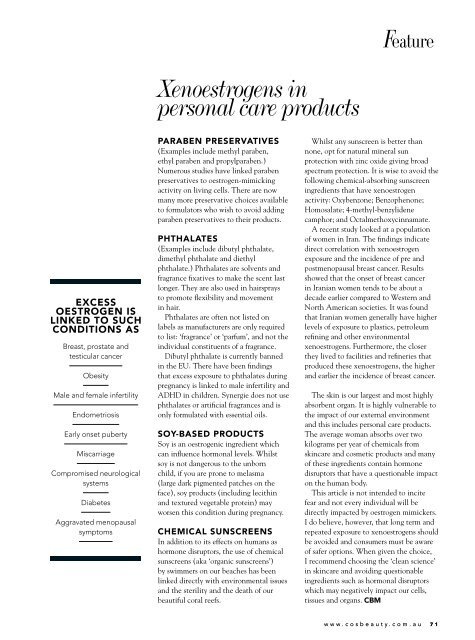CosBeauty Magazine #76
The go to beauty, health and lifestyle magazine for Australians who want to look and feel their best.
The go to beauty, health and lifestyle magazine for Australians who want to look and feel their best.
You also want an ePaper? Increase the reach of your titles
YUMPU automatically turns print PDFs into web optimized ePapers that Google loves.
Feature<br />
Xenoestrogens in<br />
personal care products<br />
Excess<br />
oestrogen is<br />
linked to such<br />
conditions as<br />
Breast, prostate and<br />
testicular cancer<br />
Obesity<br />
Male and female infertility<br />
Endometriosis<br />
Early onset puberty<br />
Miscarriage<br />
Compromised neurological<br />
systems<br />
Diabetes<br />
Aggravated menopausal<br />
symptoms<br />
Paraben preservatives<br />
(Examples include methyl paraben,<br />
ethyl paraben and propylparaben.)<br />
Numerous studies have linked paraben<br />
preservatives to oestrogen-mimicking<br />
activity on living cells. There are now<br />
many more preservative choices available<br />
to formulators who wish to avoid adding<br />
paraben preservatives to their products.<br />
Phthalates<br />
(Examples include dibutyl phthalate,<br />
dimethyl phthalate and diethyl<br />
phthalate.) Phthalates are solvents and<br />
fragrance fixatives to make the scent last<br />
longer. They are also used in hairsprays<br />
to promote flexibility and movement<br />
in hair.<br />
Phthalates are often not listed on<br />
labels as manufacturers are only required<br />
to list: ‘fragrance’ or ‘parfum’, and not the<br />
individual constituents of a fragrance.<br />
Dibutyl phthalate is currently banned<br />
in the EU. There have been findings<br />
that excess exposure to phthalates during<br />
pregnancy is linked to male infertility and<br />
ADHD in children. Synergie does not use<br />
phthalates or artificial fragrances and is<br />
only formulated with essential oils.<br />
Soy-based products<br />
Soy is an oestrogenic ingredient which<br />
can influence hormonal levels. Whilst<br />
soy is not dangerous to the unborn<br />
child, if you are prone to melasma<br />
(large dark pigmented patches on the<br />
face), soy products (including lecithin<br />
and textured vegetable protein) may<br />
worsen this condition during pregnancy.<br />
Chemical sunscreens<br />
In addition to its effects on humans as<br />
hormone disruptors, the use of chemical<br />
sunscreens (aka ‘organic sunscreens’)<br />
by swimmers on our beaches has been<br />
linked directly with environmental issues<br />
and the sterility and the death of our<br />
beautiful coral reefs.<br />
Whilst any sunscreen is better than<br />
none, opt for natural mineral sun<br />
protection with zinc oxide giving broad<br />
spectrum protection. It is wise to avoid the<br />
following chemical-absorbing sunscreen<br />
ingredients that have xenoestrogen<br />
activity: Oxybenzone; Benzophenone;<br />
Homosalate; 4-methyl-benzylidene<br />
camphor; and Octalmethoxycinnamate.<br />
A recent study looked at a population<br />
of women in Iran. The findings indicate<br />
direct correlation with xenoestrogen<br />
exposure and the incidence of pre and<br />
postmenopausal breast cancer. Results<br />
showed that the onset of breast cancer<br />
in Iranian women tends to be about a<br />
decade earlier compared to Western and<br />
North American societies. It was found<br />
that Iranian women generally have higher<br />
levels of exposure to plastics, petroleum<br />
refining and other environmental<br />
xenoestrogens. Furthermore, the closer<br />
they lived to facilities and refineries that<br />
produced these xenoestrogens, the higher<br />
and earlier the incidence of breast cancer.<br />
The skin is our largest and most highly<br />
absorbent organ. It is highly vulnerable to<br />
the impact of our external environment<br />
and this includes personal care products.<br />
The average woman absorbs over two<br />
kilograms per year of chemicals from<br />
skincare and cosmetic products and many<br />
of these ingredients contain hormone<br />
disruptors that have a questionable impact<br />
on the human body.<br />
This article is not intended to incite<br />
fear and not every individual will be<br />
directly impacted by oestrogen mimickers.<br />
I do believe, however, that long term and<br />
repeated exposure to xenoestrogens should<br />
be avoided and consumers must be aware<br />
of safer options. When given the choice,<br />
I recommend choosing the ‘clean science’<br />
in skincare and avoiding questionable<br />
ingredients such as hormonal disruptors<br />
which may negatively impact our cells,<br />
tissues and organs. CBM<br />
www.cosbeauty.com.au 71

















